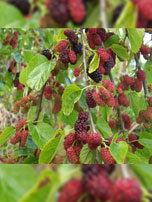SHAHEED KARTAR SINGH SARABHA AYURVEDIC MEDICAL COLLEGE & HOSPITAL
Affiliated to Guru Ravidas Ayurved University, Hoshiarpur Punjab
Affiliated to Guru Ravidas Ayurved University, Hoshiarpur Punjab

Botanical Name : Morus alba Linn.
Family : Moraceae
Introduction :
Mulberries make up the family Moraceae of the order Urticales. The representative genus is Morus. The red mulberry is classified as Morus rubra, the Texas mulberry as Morus microphylla, and the white mulberry as Morus alba.
Mulberry, common name for a family of mostly woody flowering dicot plants widespread in the tropics, with some extensions into temperate areas, and for its representative genus. The family contains about 48 genera and 1200 species and has small, clustered, unisexual flowers, typical of the nettle order, to which it belongs. Members of the mulberry family are distinguished from the other members of the order by the presence of milky sap containing latex. The female flowers are often borne on the inside of a fleshy structure called a receptacle, which expands greatly as the fruit matures. Two well-known examples are the fig and the breadfruit. The fruits of these plants actually are derived from many flowers borne on a common receptacle and are termed compound fruits.
The mulberry genus contains about seven species of trees native to the temperate and subtropical northern hemisphere. Two species are native to North America: red mulberry, widespread in the eastern United States; and Texas mulberry, a small tree or shrub that occurs scattered across the southwestern United States and northern Mexico. White mulberry has been cultivated for centuries in China, and its leaves are the main food of the silkworm. Both the tree and the worm were introduced into the United States; the attempt to form a silk industry failed, but the white mulberry has become naturalized in the eastern and southern United States. Another important member of the family is osage orange.
Names in different Indian languages :
English : Mulberry
Hindi : Tut
Malayalam : Malbari, pattunulppulu chedi
Sanskrit : Tutam, Tood
Tamil : kampilippuccicceti
Telugu : Reshmicettu, pippalipanducettu
Unani : Shahtuut, Tuut
Synonyms :
Morus indica
Morphology :
Medium size tree grows up to 2-4 m height
Leaves – simple,alternate, ovate, serrate, three veins at the base
Flowers- greenish, unisexual, small
Fruit – syncarp of many drupes
Distribution & Habitat :
All over India
Chemical constituents :
rutin, moracetin, anthocyanins , cyanidin and delphinidin glucosides; artocarpin, cycloartocarpin
Properties :
Guna : guru, snigdha;
Rasa : madhur;
Vipaka : madhur;
Virya : sheeta (raw fruit – amla Vipaka and ushna Veerya);
Karma : dahaprasamanam, vrishyam
cooling, mild laxative, anti-inflammatory, emollient, diaphoretic, expectorant, diuretic, hypotensive.
Indication :
daha, krimighna
sore throat, lumbago, hepatppathy, spleenopathy, ulcers, dyspepsia and melancholia
Part used :
Root, leaves, bark, fruit
Dosage :
Bark decoction – 50 to 100 ml
Powder 2-4 g
External uses :
Leaves are used for wound healing, especially for bed sores. Decoction of leaves is useful as gargles in stomatitis and pharyngitis.
Internal uses :
Ripe fruit is appetizer and carminative. Bark is purgative and anthelmintic. Fruits and bark are used in loss of appetite, flatulence, constipation and intestinal worms. It is very useful in tape worm. Syrup of ripe fruits is useful in heart diseases, bleeding disorders, burning sensation and debility.
Therapeutic Uses :
Bark decoction useful in constipation.
